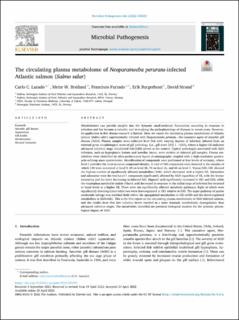| dc.description.abstract | Metabolomics can provide insights into the dynamic small-molecule fluctuations occurring in response to infection and has become a valuable tool in studying the pathophysiology of diseases in recent years. However, its application in fish disease research is limited. Here, we report the circulating plasma metabolome of Atlantic salmon (Salmo salar) experimentally infected with Neoparamoeba perurans—the causative agent of amoebic gill disease (AGD). Plasma samples were collected from fish with varying degrees of infection inferred from an external gross morphological score of gill pathology (i.e., gill score [GS] 1 -- GS3), where a higher GS indicates advanced infection stage. Uninfected fish (GS0) served as the control. Typical pathologies associated with AGD infection, such as hyperplastic lesions and lamellar fusion, were evident in infected gill samples. Plasma metabolites were identified by ultra-performance liquid chromatography coupled with a high-resolution quadrupole-orbitrap mass spectrometer. Identification of compounds were performed at four levels of certainty, where level 1 provided the most accurate compound identity. A total of 900 compounds were detected in the samples of which 143 were annotated at level 3, 68 on level 2b, 74 on level 2a, and 66 on level 1. Versus GS0, GS1 showed the highest number of significantly affected metabolites (104), which decreased with a higher GS. Adrenaline and adenosine were the two Level 1 compounds significantly affected by AGD regardless of GS, with the former increasing and the latter decreasing in infected fish. Hippuric acid significantly increased in GS1 and GS2, while the tryptophan metabolite indole-3-lactic acid decreased in response to the initial stage of infection but returned to basal levels at a higher GS. There were ten significantly affected metabolic pathways: Eight of which were significantly downregulated while two were downregulated in GS1 relative to GS0. The super-pathway of purine nucleotide salvage was enriched both within the upregulated metabolites in GS1vsGS0 and the down-regulated metabolites in GS3vsGS1. This is the first report on the circulating plasma metabolome of AGD infected salmon, and the results show that low infection levels resulted in a more dramatic metabolomic dysregulation than advanced infection stages. The metabolites identified are potential biological markers for the systemic physiological impact of AGD. | |
